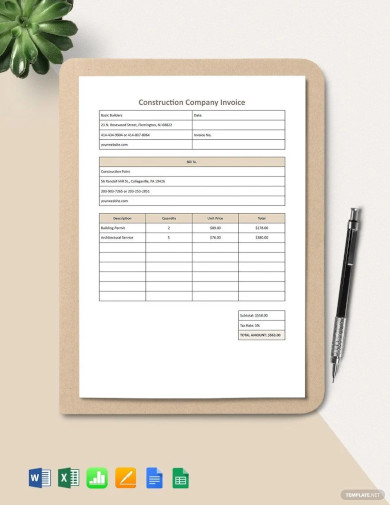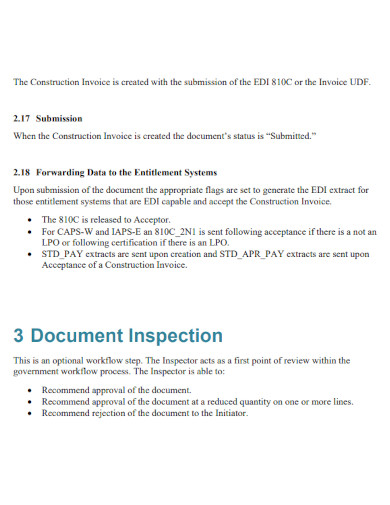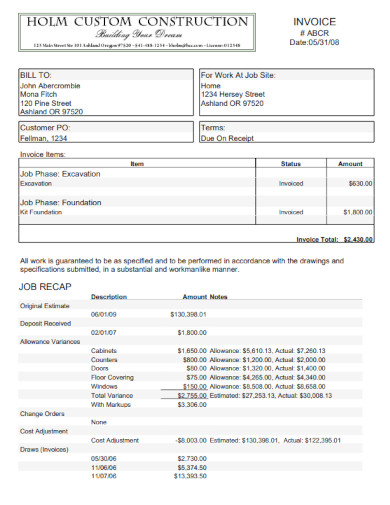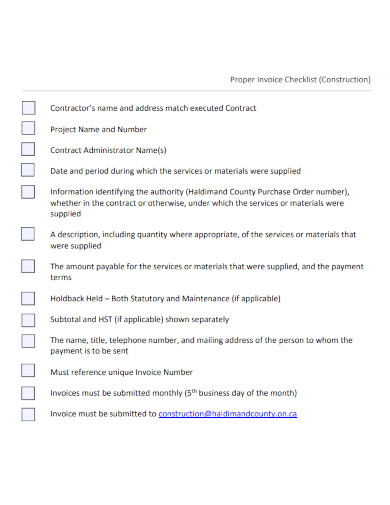An electrical invoice is a professional document used by electricians or electrical companies to bill clients for services provided. It includes details of labor, materials, and additional charges related…
continue reading
20+ Sample Construction Invoice
-

Construction Subcontractor Invoice
download now -

Construction Work Invoice
download now -

Construction Service Invoice
download now -

Construction Company Invoice
download now -

Construction Cleaning Invoice
download now -

Printable Construction Invoice
download now -

Sample Construction Invoice
download now -

Construction Project Invoice
download now -

Construction Invoice Format
download now -

Vendor Construction Invoice
download now -

Construction Contractor Invoice
download now -

Construction Client Invoice
download now -

Construction Service Agreeemnt Invoice
download now -

Business Construction Invoice
download now -

Construction Payment Invoice
download now -

Construction Fixed Price Invoice
download now -

Building Construction Invoice
download now -

Construction Work Invoice Example
download now -

Construction Invoice Checklist
download now -

Invoice Financing for a Construction Company
download now -

Professional Construction Invoice
download now
A construction invoice is a detailed bill presented by a contractor, subcontractor, or supplier in the construction industry to a client or general contractor. This invoice outlines the work that has been completed or the materials that have been supplied and requests payment for these services or goods.
Essential Components of a Construction Invoice
In the field of construction, invoices play a crucial role in connecting the services provided with the expected financial compensation. They not only outline the details of a transaction but also establish a clear path for payment. As invoices are vital in the construction industry, it is essential to ensure that they are thorough, easy to understand, and precise. Here is a breakdown of the key elements that should be included in a construction invoice:
Header Information
Company Information: This includes the name of the construction company, address, contact number, and any other relevant details.
Client Information: Detailed contact information of the client or company being billed.
Invoice Number: A unique identifier for each invoice, crucial for record-keeping and tracking.
Invoice Date: The date when the invoice is issued.
Due Date: The date by which the payment should be made.
Project Details
Project Name/Title: A specific name or identifier for the construction project.
Project Location: Detailed address or description of the project’s location.
Project Description: A brief overview of the nature of the project.
Detailed Work Descriptions
Labor: Itemized list of labor services provided, along with their respective durations and rates.
Materials: List of materials supplied, their quantities, and costs.
Equipment: Any equipment rented or used, along with respective costs.
Pricing and Rates
Unit Rates: Cost per unit for materials or per hour for labor.
Total Cost: Cumulative amounts for labor, materials, and equipment.
Additional Charges: This might include transport, insurance, or any other ancillary costs.
Tax Details
Tax Identification Number (TIN): For tax purposes, especially if dealing with businesses.
Tax Breakdown: Detailed breakdown of applicable taxes, whether sales tax, value-added tax (VAT), or others, with their respective percentages.
Change Orders: If any alterations or additions were made to the initial contract, their descriptions and associated costs should be clearly listed.
Subtotal and Total Amounts
Subtotal: Amount before taxes or additional charges.
Total: The final amount due, inclusive of all taxes and charges.
Payment Terms and Conditions
Accepted Payment Methods: Whether via bank transfer, check, credit card, etc.
Late Payment Policies: Information on interest rates or fees for late payments.
Retention Amount: If a certain amount is to be retained and paid upon completion, it should be indicated.
Certifications or Attestations
In certain jurisdictions or for specific project types, certification that the work has been completed as per contract terms might be necessary.
Footer Information
Company Seal or Logo: To authenticate the invoice.
Signature: The signature of the authorized person, signifying the validation of the invoice’s details.
By ensuring that a construction invoice incorporates all these components, contractors can foster clarity, facilitate prompt payments, and establish a foundation of trust and transparency with their clients. Moreover, in the event of disputes, a detailed payment invoice serves as an invaluable document, providing insights and evidence into the specifics of the transaction.
Distinguishing Between Estimate, Quote, and Invoice
While often used interchangeably, estimates, quotes, and invoices have distinct roles in construction. Estimates provide an approximate idea of costs, serving as preliminary information. Quotes, on the other hand, are more binding and showcase a contractor’s commitment to a specific price. Invoices are the culmination, delineating performed work and material costs, thus prompting the client’s payment. Recognizing their functional differences is imperative to avoid confusions and disputes.
Common Mistakes to Avoid in Construction Invoicing
Construction invoicing is a crucial part of the financial dealings in the industry. Accuracy and clear communication are vital to ensure prompt payments and transparent relationships. Unfortunately, many contractors frequently encounter typical errors that can result in disagreements, delayed payments, or even financial discrepancies. Here are a few mistakes to steer clear of
Vague Descriptions
Avoid general terms like ‘services provided’. Instead, detail the specific tasks or materials used, such as ‘electrical installations’ or ‘cement supplies’.
Pricing Errors
Outdated Rates: Material and labor costs can change. Always ensure current rates are applied.
Miscalculations: Ensure all arithmetic, especially with taxes or discounts, is correct.
Omitting Important Dates
Include service rendered dates, materials supply dates, invoice issue dates, and due dates for clarity and to prevent misunderstandings.
Neglecting Tax Implications
Incorrect Tax Rates: Always apply the right tax rate for specific services or materials.
Missed Exemptions: Be aware of any tax exemptions for certain services or materials.
Failure to Itemize
Bundle services or materials together can lead to confusion. Always break down costs for transparency.
Ambiguous Payment Terms
Clearly mention due dates, accepted payment methods, and any penalties for late payments.
Overlooking Change Orders
If project specifications change and costs are incurred, they must be invoiced. Missing these can lead to revenue losses.
Using Outdated Contractual Details
Always base invoices on the most recent and agreed-upon contract terms.
Duplicate Invoicing
Ensure each invoice is unique to avoid confusion or perceived unprofessionalism.
Poor Record Keeping
Always maintain copies of sent invoices for future reference, especially in the event of disputes.
Ignoring Retention Amounts
Some contracts retain a percentage of the total till project completion. Ensure your invoices account for this.
Inconsistent Invoicing Practices
Keep a standard format and frequency for invoicing to maintain clarity and professionalism.
Avoiding these common mistakes not only ensures the financial accuracy of construction projects but also solidifies trust between clients and contractors, forming the basis for lasting professional relationships.
When should We use a construction invoice?
A construction invoice is used to request payment for construction work that has been completed or is in progress. Here are the typical situations when you should use a construction invoice:
Completion of Work
When a specific task, project phase, or the entire project is completed, an invoice should be sent to the client to request payment for the completed work.
Milestone-Based Billing
Some construction contracts are structured around milestones. For instance, once the foundation is laid, the contractor may invoice for that portion of the work. Subsequent milestones, such as completing the framing, roofing, or finishing, could each generate a new invoice.
Recurring Billing:
If there’s an agreement to bill the client periodically (e.g., weekly, monthly) regardless of the project stage, you’d use an invoice for each billing cycle.
Material Procurement:
If the contract stipulates that the client is responsible for paying for materials, you might send an invoice once the materials are procured, even before the actual construction work begins.
Change Orders:
During construction, clients might request changes that weren’t part of the original agreement. If these changes involve additional costs, you’d use an invoice to bill for the extra work or materials.
Retainage Release:
Some contracts include a retainage clause where a percentage of the total bill is held back until the end of the project to ensure completion. Once the job is finished and meets the client’s standards, an invoice can be issued for the retained amount.
Special Services or Rentals:
If you provide special services or equipment rentals outside the standard scope of the project (e.g., crane rental, specialized machinery, or additional consultations), these could be invoiced separately.
Maintenance or Follow-Up Work:
If, after the primary construction work is done, you’re hired to do maintenance or other follow-up tasks, you’d invoice for these separately.
When using a construction invoice, it’s essential to:
- Clearly list all services, materials, and work performed, along with corresponding costs.
- Provide a breakdown of costs, so the client understands what each charge represents.
- Include payment terms, due dates, and any applicable late fees or interest charges.
- Ensure that the invoice format and details align with the agreement or contract with the client.
FAQ’S
Why is a construction invoice necessary?
It provides a clear record of services and materials for which payment is due. It ensures transparency between parties and serves as a reference in case of disputes.
How often should construction invoices be issued?
This varies based on the agreement. Some projects prefer milestone-based invoicing, while others might opt for weekly, bi-weekly, or monthly billing.
What’s the difference between a quote and an invoice?
A quote provides an estimated cost for a project or service, given before the work starts. An invoice bills for services or materials provided after the work has been done.
What should I do if there are errors in the invoice received?
Notify the sender immediately upon spotting discrepancies. Both parties should review the terms and correct the invoice accordingly.
How long should I keep a copy of a construction invoice?
It’s advisable to retain invoices for at least six years. This period allows for reference in potential disputes and for tax-related purposes.
What do I do if my invoice isn’t paid on time?
First, communicate with the client to understand any reasons for non-payment. If there’s no resolution, you may consider adding late fees (if stipulated in the contract), sending a formal demand letter, hiring a collection agency, or pursuing legal action.
Can I include both labor and materials on one invoice?
Yes, most construction invoices will have separate line items for labor and materials to provide clarity to the client.
What is retainage on a construction invoice?
Retainage is a portion of the agreed contract price withheld until the final work is fully completed and inspected. It’s a way to ensure that contractors complete projects according to agreed-upon standards. Once the project is completed satisfactorily, the retainage is released.
Construction invoices serve as more than just payment requests; they are essential for financial transparency in the construction industry. Creating detailed, clear, and comprehensive invoices not only ensures smooth financial plans but also strengthens the trust between contractors and clients.


